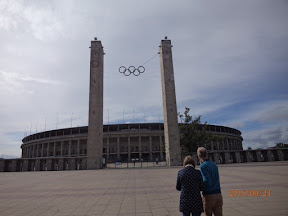Today we had to get up at 6am in order to catch an early train - then the train was half an hour late! It made up time on the way though, so we were only a few minutes late arriving in Berlin, around 1.30
We were due to have a city tour, but the traffic was truly awful because of a demonstration of some sort which started at the main station, where we arrived, and ended at the Brandenburg Gate, where we were supposed to visit later but couldn't because of appalling traffic and blocked off streets. At first we couldn't even get to our coach because of all the demonstrator's buses and the press of people. Because of the heavy traffic due to the demo and the road closures, we couldn't follow the tour plan, and didn't see everything that had been planned for us.
Our first stop was the Victory Column. It wasn't night time as you might think from this photo, it was just a dreadfully overcast day.

The column was designed1864 to commemorate the Prussian victory in the Danish-Prussian War, but by the time it was erected in1873, Prussia had also defeated Austria in the Austro-Prussian War (1866) and France in the Franco-Prussian War (1870–71), so it different from the original plans. These later victories inspired the addition of the bronze sculpture of Victory on the top.
Our next stop was the Charlottenburg Palace which is the largest palace in Berlin.

The original palace was commissioned by Sophie Charlotte, the wife of Friedrich III, Elector of Brandenburg. It was designed in baroque style and completed in 1699.
Friedrich crowned himself as King Friedrich I in Prussia in 1701, and had the palace extended the following year. Sophie Charlotte died in 1705 and Friedrich named the palace and its estate Charlottenburg in her memory.
We also stopped at the Olympic Stadium, built to house the 1936 Olympic Games.

The area was used by the British Military after World War II, and during the 1960s it was used by the American forces for American Football. It was renovated in 2000, and today it is a multi-purpose arena and is used for international football matches.
We made a stop for coffee at The Topography of Terror, an outdoor and indoor history museum located on the site of buildings which during the Nazi regime (1933 to 1945) were the headquarters of the Gestapo and the SS.
The buildings were largely destroyed by Allied bombing during early 1945 and the ruins were demolished after the war. You can still see the walls of the basement, used for a prison. The boundary between the American and Soviet zones of occupation in Berlin ran along here, so the street soon became a fortified boundary, and the Berlin Wall ran along the south side of the street. The wall here was never demolished, so we were able to take photographs of it.

People are standing in what used to be the basement prison, with the remains of the Berlin Wall behind. The dreadful totalitarian looking building in the background is not contemporary with the Nazi headquarters but looks very threatening I think.
We drove past a public square called the Bebelplatz, which is known as the site of one of the infamous Nazi book burning ceremonies held in 1933 in many German university cities.

Joseph Goebbels made an inflammatory speech before the burning which was attended by members of the Nazi Students' League, the SA ("brownshirts"), SS and Hitler Youth groups. They burned around 20,000 books, including works by Heinrich Mann, Erich Maria Remarque, Karl Marx, Albert Einstein and many other authors.
I'm afraid I wasn't quick enough with some of my photos as we drove past - I ruined a photo of Checkpoint Charlie, and a bus got in the way of my attempt on the Brandenburg Gate as we drove past. I hope to do better tomorrow.
I did manage to photograph the Reichstag building, constructed in 1894 to house the German Imperial Diet (equivalent of the Parliament I suppose).

It housed the Diet until 1933, when it was severely damaged in a fire. After World War II, the building fell into disuse; the parliament of the German Democratic Republic met in East Berlin, while the parliament of the Federal Republic of Germany met in Bonn.
The ruined building was made safe against the elements and partially refurbished in the 1960s, but no attempt at full restoration was made until after German reunification in1990, when it underwent a reconstruction, led by Norman Foster. After its completion in 1999, it once again became the meeting place of the German parliament.
It had become quite late by then, so the coach took us to the hotel to check in and have dinner. Tomorrow is another day!
- Posted using BlogPress from my iPad
No comments:
Post a Comment